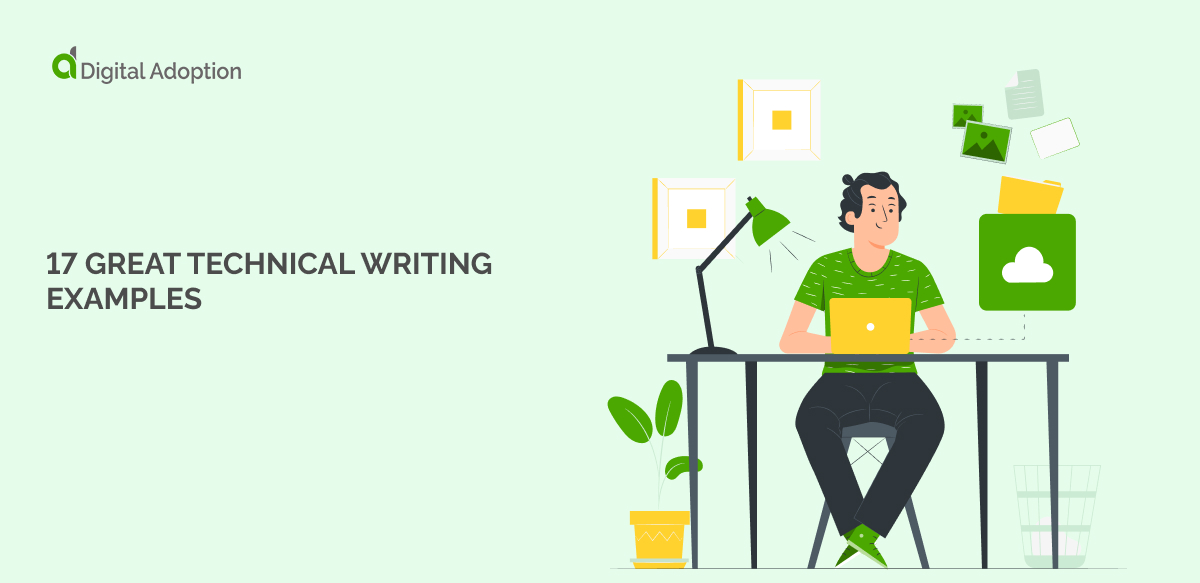Your products are of little value to customers unless they know how to use them. Technical writing has the potential to promote product stickiness and digital adoption of new technologies.
Your business plans need specific and technical expertise to record them correctly so they are easy to follow and can drive digital transformation.
The number of technical writer roles will likely grow by 7% from 2022 to 2032. This statistic shows that the need for technical writing will increase over the next ten years and that organizations now accept they need these experts for many business purposes.

This article covers 17 comprehensive and detailed examples.
When you finish reading, you’ll know what technical writing you need for every purpose.
This knowledge will make your products easy to use, and based on structured, well-documented plans and outstanding user support, you will position your organization strongly against competitors.
17 Examples of technical writing

These 17 common examples of technical writing cover everything an enterprise might need. Take a look and find something relevant to your organization that fulfills a need, and invest today.
- User guides
Image: manula
User guides are instructional manuals designed to help users understand and operate products or systems during customer onboarding.
These documents provide step-by-step instructions, troubleshooting tips, and detailed explanations of features and functions.
User guides are crucial for enterprises. They improve user experience by helping customers use products efficiently, reducing support needs, boosting satisfaction, and cutting costs. One enterprise example is a user guide for new employees on company software and policies.
Enterprises can integrate user guides into support and training, offer digital versions, and enhance them with multimedia for better engagement.
- Release notes
Image: markvsql
Release notes document changes, fixes, and enhancements in software updates.
Enterprises use them to inform users about updates, new features, bug fixes, and product improvements.
Using release notes has many benefits. They help manage user expectations, reduce confusion, and provide a record of modifications.
Release notes support internal teams by documenting progress and facilitating communication across departments. They enhance user satisfaction and trust while streamlining internal processes and development cycles.
- Company documents
Image: nimbusweb
Company documents like employee handbooks and orientation manuals demand precise technical writing skills and deep organizational understanding.
Enterprises utilize company notes to document key decisions, strategies, and communications, ensuring consistent information flow and team alignment. One example is an employee handbook outlining company policies, benefits, and code of conduct.
These notes track progress, record meeting outcomes, and serve as references. The benefits are enhanced transparency, onboarding, compliance, and accountability.
- Technical reports
Image: datadrivenu
Technical reports offer comprehensive insights into specific technical subjects. They present detailed findings, analyses, and recommendations.
Enterprises often use technical reports to document research, development, and analyses. These reports share detailed information, aid decision-making, guide project development, and facilitate collaboration. One example is a technical report on the feasibility study for a new product prototype.
They also record innovations and problem-solving efforts, supporting future reference and continuous improvement, enhancing knowledge management, transparency, and operational efficiency.
- Standard Operating Procedures (SOPs)
Image: helpjuice
Standard operating procedures (SOPs) are holistic processes. They help employees work together and accomplish various organizational tasks.
SOPs are process documentation that ensures smoother internal operations and workflows. An example is the SOP for inventory management in warehouse operations. Other examples include SOPs for payroll processing and manufacturing guidelines.
SOPs make business processes more efficient and economical.
- Technical specifications
Image: smartsheet
Technical specifications define the precise requirements and capabilities of products or systems.
Enterprises leverage technical specifications to outline detailed requirements and standards for products or systems. A common example is the technical specifications for designing and constructing a new office building.
These specifications ensure consistent quality, guide development processes, facilitate team communication, and support compliance with industry standards. These benefits enhance efficiency and product reliability.
- Knowledge-base articles
Image: invgate
Knowledge base articles provide solutions to common issues and best practices. Enterprises empower users and support teams to troubleshoot independently.
Enterprises utilize knowledge-based articles to provide detailed information and solutions for common issues. A frequent and useful example is a knowledge-based article on troubleshooting common software installation issues for employees.
These articles support customer self-service, reduce support requests, and enhance user satisfaction. They also streamline employee training and ensure consistent, accessible information across the organization.
- User manuals
Image: document360
User guides are instructional manuals designed for inexperienced end-users. They assist users with products ranging from consumer electronics and appliances to B2B SaaS tools and solutions.
These guides are user-friendly and contain several illustrations. The illustrations and text emphasize common issues and features. One example you might have encountered before is a user manual for operating and maintaining industrial machinery on the production floor.
Technical writers must collaborate with engineers, programmers, and product designers to ensure comprehensive product coverage.
- Software documentation
Image: Altexsoft
Computer software needs accompanying documentation. Installation guides, for example, help users navigate the implementation and installation process.
A well-crafted installation guide should include detailed workflows, video tutorials, FAQs, and a troubleshooting section.
Programmers often automate the process, while the technical writer creates alert boxes and the ReadMe file. An example of this type of technical writing is enterprise software documentation detailing installation, configuration, and usage procedures for customer relationship management (CRM) software.
Software documentation tools make creating, publishing, and maintaining these installation guides easy.
- Training materials
Training materials deliver structured content. This content educates employees on processes, software applications, or essential skills and can speed up the process of digital adoption of new technologies.
Another function of training materials is to standardize training practices across departments. Doing so ensures a skilled and knowledgeable workforce. A useful example is training materials for new employees covering customer service skills and company policies.
These materials are crucial in enterprise environments. They facilitate the effective onboarding of new hires and promote continuous professional development.
- Troubleshooting guides
Image: clickhelp
Troubleshooting guides outline systematic steps for efficiently diagnosing and resolving technical issues as part of customer continuity.
Enterprises leverage troubleshooting guides to help users independently diagnose and resolve issues with products or systems. These guides provide step-by-step instructions and solutions to common problems, improving customer support efficiency.
One common example is a troubleshooting guide for diagnosing network connectivity issues in office environments.
These guides minimize service disruptions and optimize support processes.
- Whitepapers and case studies
Image: Datanalytics
Case studies and whitepapers are industry-specific documents. These documents showcase real-world examples.
Case studies appear in a passive voice and focus on specific instances. They provide vital takeaways and frequently use data to emphasize benefits. An example is a case study highlighting the implementation of a cloud-based ERP system in a multinational corporation.
Conversely, whitepapers tackle particular challenges and utilize the active voice. Technical writers who create these documents should have comprehensive industry knowledge to write effectively. One example is a whitepaper on the future of sustainable packaging in the consumer goods industry.
Case studies and whitepapers demonstrate an organization’s expertise and value and are helpful for lead generation.
- Business plans
Image: visme
Business plans communicate a company’s strategic goals, operational strategies, and financial forecasts. In enterprise settings, they serve as foundational documents.
A useful example is a business plan outlining expansion into new markets for a technology startup company.
These plans guide decision-making, attract investors, and align teams to achieve long-term objectives. They also promote sustainable business growth and competitive advantage.
- API documentation
Image: stoplight
API documentation enables developers to see and change a software product’s code. It facilitates API implementation.
It provides comprehensive instructions and tutorials. These instructions and tutorials simplify integration with other APIs, including web, software, and SCPIs. This documentation often includes code samples, usage scenarios, and detailed explanations.
A great example of API documentation details endpoints, authentication methods, and data formats for integrating payment processing services into e-commerce platforms.
API documentation benefits enterprises by guiding developers in integrating services, ensuring compatibility, accelerating development, and enhancing product interoperability and functionality.
- Annual reports
Image: zapier
Annual reports summarize a company’s financial performance. They also record achievements and strategic objectives over a fiscal year.
Large organizations use annual reports to communicate financial performance, strategic achievements, and plans to stakeholders and investors.
An ideal example is an annual report summarizing a global telecommunications company’s financial performance, strategic initiatives, and market outlook.
These reports are pivotal for enhancing stakeholder transparency and maintaining investor confidence. They demonstrate accountability through precise, detailed assessments of organizational accomplishments and future directions.
- Service-level agreements (SLAs)
Image: fluentsupport
An SLA is a legally binding agreement between a provider and a customer. It details the services offered and defines the guarantees, warranties, and other mutually negotiated terms.
An example of a service level agreement is defining response times and resolution benchmarks for IT support services.
This contract ensures both parties understand expectations, responsibilities, and performance standards. It promotes transparency and accountability and a reliable and productive business relationship.
- Request for proposal (RFP)
Image: responsive
An RFP (Request for Proposal) is a business document. It announces a project and invites bids from multiple qualified contractors.
The RFP writing style is persuasive, and its quality can determine the deal’s success. A well-crafted RFP should clearly outline the project goals and explain challenges, the scope of the work, and evaluation criteria.
An example of a request for proposal could involve soliciting bids from qualified vendors for a new software development project.
Review the above technical writing examples and consider which is best for your organization to promote user-centricity and capability.
Use technical writing to drive user capability
Technical writing drives enterprise user capability. It provides clear, precise documentation. This documentation helps employees and customers understand and use complex systems and tools.
For example, a user guide increases customer capability for a new product. It ensures they optimize its use and have a positive experience. This guide makes them more likely to buy more products from the same company as they understand the value of the products.
Technical writing enhances productivity, reduces errors, and streamlines workflows when employees can use new software quickly using training guides.
This user-centricity leads to improved efficiency and better decision-making. It also provides a competitive edge in the market.







![18 Examples of AI in Finance [2025]](https://www.digital-adoption.com/wp-content/uploads/2025/06/18-Examples-of-AI-in-Finance-2025-300x146.jpg)
![14 Examples of AI in Manufacturing [2025]](https://www.digital-adoption.com/wp-content/uploads/2025/06/14-Examples-of-AI-in-Manufacturing-2025-300x146.jpg)




